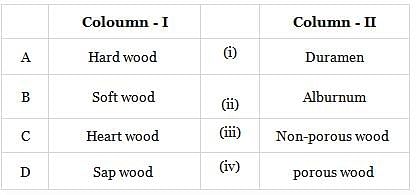Test: Secondary Growth (NCERT) - NEET MCQ
20 Questions MCQ Test NCERTs at Fingertips: Textbooks, Tests & Solutions - Test: Secondary Growth (NCERT)
Identify the given figure and select the correct labels for A, B and C.




In dicot stems, cambium present between primary xylem and primary phloem is
| 1 Crore+ students have signed up on EduRev. Have you? Download the App |
Which of the following statements is correct about a woody dicot stem which shows extensive secondary growth?
In old trees, central dark coloured, non-conducting part of secondary xylem is referred to as
Which of the following options correctly shows the sequence of different tissues of the periderm starting from periphery?
Match Column-I with Column-II and select the correct answer from the codes given below.

Match Column-I with Column-II and select the correct answer from the codes given below.

During the secondary growth in a dicotyledonous stem, the fusiform initials of vascular cambium give rise to
Cork is impervious to water due to the presence of _______ in its cell wall.
Bark formed early in the season is called as________ bark and bark formed towards the end of the season is called as _________bark.
During secondary growth in a dicot root, cork cambium is formed by the activity of
Match Column-I with Column-II and select the correct answer from the codes given below.

Bark of which of the following plants yields a drug for the treatment of malaria?
Match Column-I with Column-II and select the correct answer from the codes given below.

|
304 docs|275 tests
|
|
304 docs|275 tests
|

















